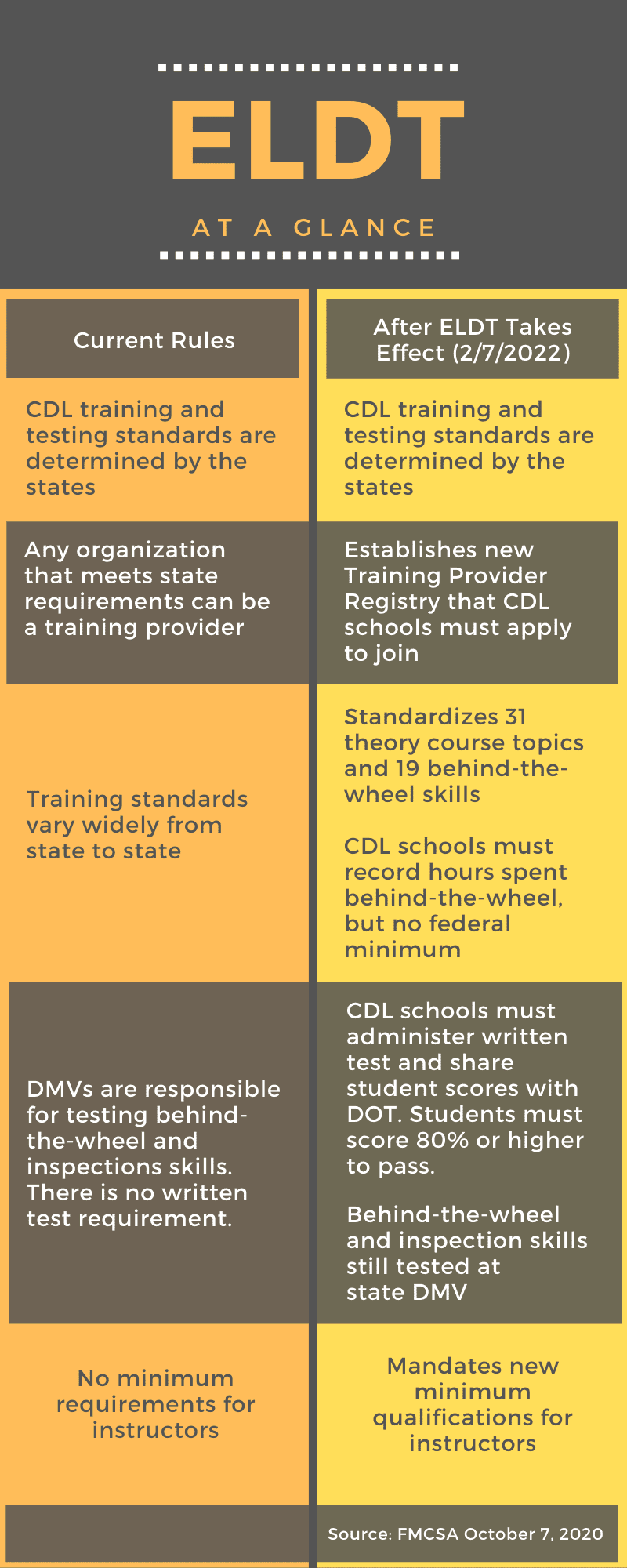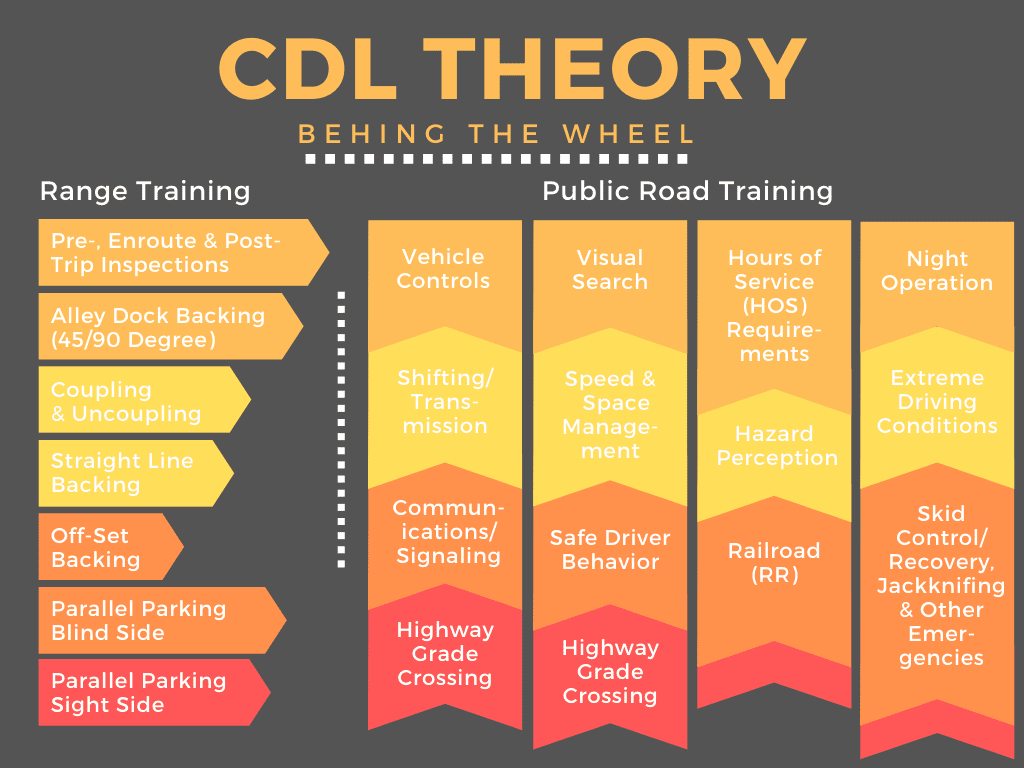Commercial Driver’s License Training Tips – Part I
You’ve made the decision to join one of the most important professions in the world: To become a Professional Class A CDL Truck Driver. THANK YOU! Let’s get you set up for success.
Why You Should Go to Trucking School
Technically, you could study and test for your Commercial Driver’s License without going to a school or a company-sponsored CDL Training Program.
However, you likely won’t be able to get a job. Going to an accredited/certified trucking school will open more doors to you and better pay.
Due to insurance requirements, company safety policies, and FMCSA regulations, most companies require new drivers to have attended and graduated from a certified or accredited school that meets the FMCSA’s Entry-Level Driver Training regulations and the candidate must earn a Certificate of Completion that meets all parts of 383.51 FMCSA (Disqualification of Drivers) requirements.
Licensed, Certified, and Accredited CDL Trucking Schools
What’s the difference? Here’s a quick summary:
- Licensed Truck Driving Schools: Reviewed by a state agency and have met the state’s minimum requirements. It’s regulated and licensed by the state agency and must meet that state’s requirements.
- Certified Truck Driving Schools Reviewed and inspected by a 3rd party that measures the school against industry standards. Students only graduate when they pass the US DOT skills and knowledge standards for the trucking industry.
- Accredited Truck Driving Schools: Been through an approval process conducted by an accrediting agency authorized by the US Department of Education to accredit schools that meet certain federal standards.
Quick Guide from FMCSA State Licensing Requirement for CDL Schools: Click Here to Download PDF Guide
About FMCSA’S Entry-Level Driver Training Regulations
FMCSA sets a baseline for training requirements for entry-level drivers (getting their Class A for the first time, upgrading from a Class B to a Class A, or obtaining endorsements for the first time). An entry-level driver must, prior to taking the CDL test, successfully complete a prescribed program of theory and behind-the-wheel instruction provided by a school or other entity listed on FMCSA’s Training Provider Registry (TPR).
Entry-Level Driver Training Regulations
Entry-Level Driver Training (ELDT) Regulations will update on February 7, 2022. Most trucking schools and companies with a CDL Training Program that helps the candidate attain their CDL are already in progress to update to these new regulations. If you’re looking for a trucking school, look for these elements of a Classroom and behind-the-wheel training program.
Here’s a side-by-side of Current Rules and After ELDT Takes Effect:

CDL Theory Classroom + Behind the Wheel Range and Public Road Training
After the ELDT Takes effect in February 2022, all truck driver training schools will need to adopt 31-course theory topics and defined behind-the-wheel skills that cover a wide range of topics from Post-Crash Procedures to Roadside Inspections and more. Check it out:

The 383.51 FMCSA Requirements (Disqualification of Drivers)
All drivers must meet FMCSA requirements. If an employer knows or reasonably should know, that a driver is disqualified, it must not allow the disqualified driver to operate a CMV. The offense and the driver’s record of prior convictions will determine the disqualification period of a driver. Note, this may vary by company. By and large, there’s a waiting period prior to becoming eligible for a disqualifying odetermineffense. Major and serious offenses require driver disqualification even if the CDL holder is driving a non-CMV. For example, speeding over 15 miles per hour even in your personal vehicle will disqualify you for a period of 60-days-1 year depending on the company.
Disqualifying Offenses: Major
Minimum Disqualification: One Year
- Driving under the influence of alcohol as prescribed by State law.
- Driving under the influence of a controlled substance.
- Having an alcohol concentration of .04 or greater while operating a CMV.
- Refusing to take an alcohol test as required by implied consent laws or regulations.
- Leaving the scene of an accident.
- Using the vehicle to commit a felony.
- Driving a CMV while revoked, suspended, canceled, or disqualified as a result of prior violations committed while operating a CMV.
- Causing a fatality through the negligent operation of a CMV.
- Using the vehicle in the commission of a felony involving the manufacturing, distributing, or dispensing of a controlled substance (mandatory lifetime disqualification).
Disqualifying Offenses: Serious
Minimum Disqualification: 60 Days
- Speeding excessively (15 mph or more over the speed limit).
- Driving recklessly.
- Making improper or erratic traffic lane changes.
- Following the vehicle ahead too closely.
- Violating State or local law relating to motor vehicle traffic control arising in connection with a fatal accident.
- Driving a CMV without obtaining a CLP or CDL or without a CLP or CDL in the driver’s possession.
- Driving a CMV without the proper class license and/or endorsements.
- Violating laws relating to prohibiting texting or using a handheld mobile telephone while driving a CMV.
- See 49 CFR 383.51 for a list of all offenses and disqualifying periods for drivers convicted of an offense.
Conclusion
This completes this installment of Commercial Driver’s License Training Tips. In Part II, we’ll discuss questions you should ask of CDL Schools/Training Programs before signing up.
Have a question? Give our recruiting team a call at 855-784-5627 and we’d be happy to assist you.
Disclaimer: PTI is not a CDL truck driving school. PTI is not an affiliate of any CDL truck driving school, but does have partnerships with select schools in the Midwest and Southeast for job placement. Once a candidate has attained their Commercial Driving License, they may be eligible for PTI’s CDL Finishing Program. Call 855-784-5627 if you would like to learn more.

